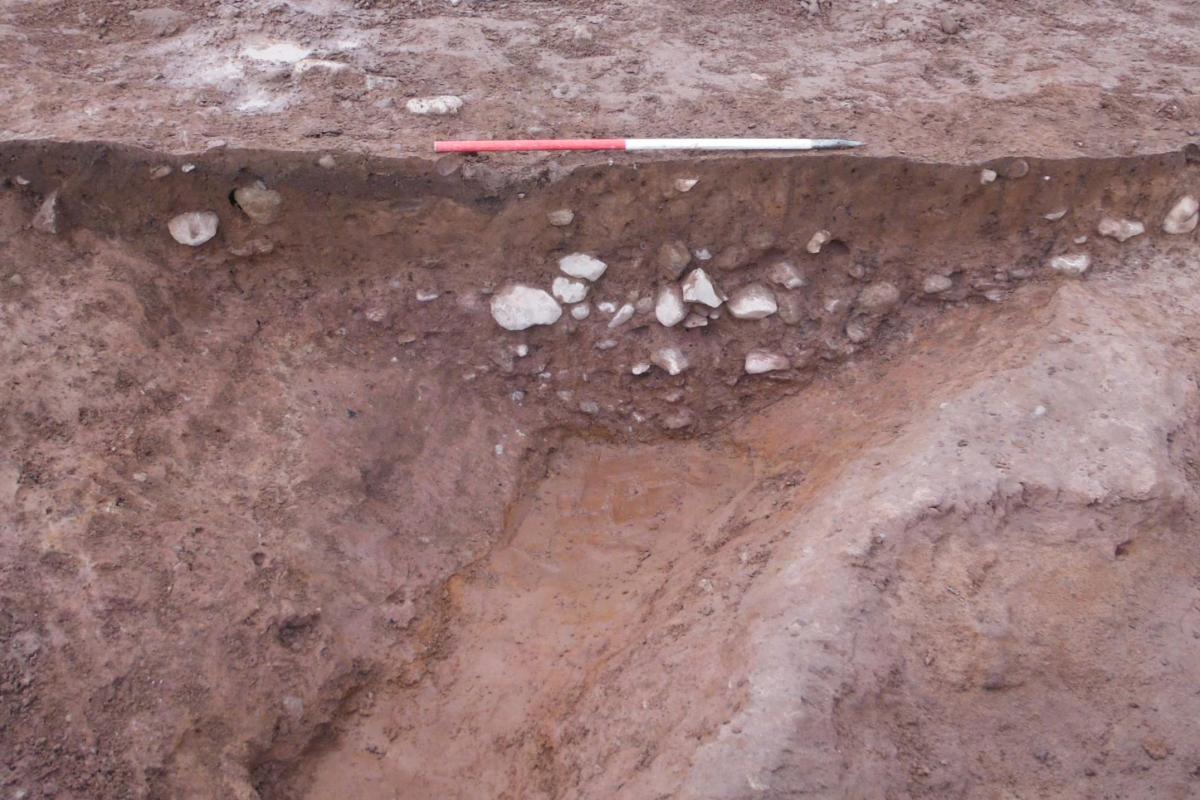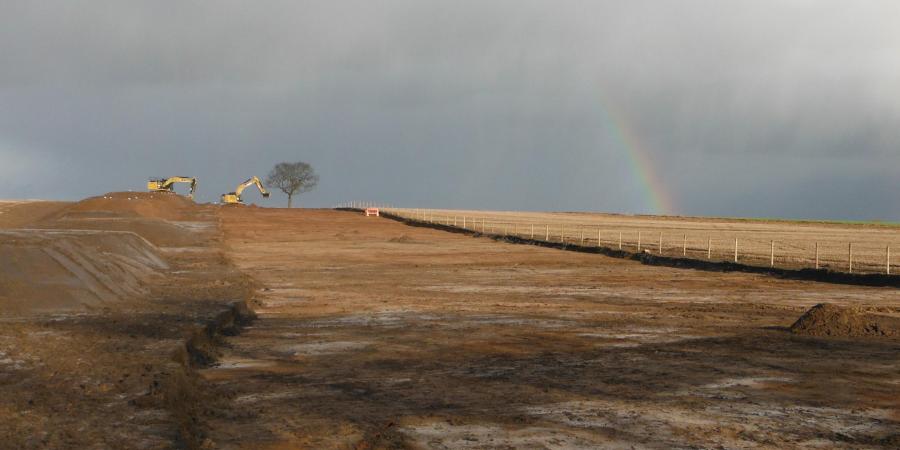Since 2012 staff from Wessex Archaeology have been working on the A556 Knutsford to Bowdon road improvement project, commissioned by Costain Group PLC, on behalf of Highways England. Fieldwork took the form of evaluation trial trenching, watching briefs and a strip, map and record excavation. The results have since been the focus of an extensive programme of post-excavation study and scientific analysis. Undertaken under the aegis of Highways England and the North West Regional Science Advisor for Historic England, the post-excavation phase is drawing to a close and results will be published in The Archaeological Journal.
Fieldwork results
The geophysical survey indicated a rather archaeologically sparse landscape dotted with post-medieval features such as field boundaries, drains, pits and a brick kiln. The trench evaluation corroborated these findings but also exposed a pit containing cremated human bone close to Bucklow Hill, where aerial photographs had previously revealed the possible site of a Bronze Age barrow cemetery.
Consultation with local and national authorities led to a 9 ha strip, map and sample excavation along an 850 m stretch of the new road where it passed Bucklow Hill.
The resultant excavation identified two barrows set some 90 m apart. The western barrow was better preserved and had been more used more heavily: it had a surviving ring ditch and nearly 40 deposits of cremated bone including the remains of one relatively intact urned burial. At the eastern barrow, 16 deposits of cremated bone were found; none of the burials were urned and no monumental structures such as a ring ditch survived.

Left: a cross section of the ring-ditch around the western barrow. Right: the Middle Bronze Age cremation urn.
Other features found on the Bucklow Hill site included pits with fire-cracked rocks or iron-smithing slag and undated ditched enclosures, along with a grid of infilled ditches that matched the enclosures shown on 19th-century tithe maps.
Post-excavation study
In addition to standard artefactual and environmental studies, radiocarbon dating, organic residue analysis and ceramic petrography were undertaken.
Over 30 samples were carefully selected for radiocarbon dating, and the results were modelled using a Bayesian approach, meaning statistical analysis was used to refine and interpret the results. This revealed that the burying of cremated bone at the western barrow began at the earliest around the 20th century cal BC (in the Early Bronze Age) and ended at the latest around the 15th century cal BC (Middle Bronze Age), with the latest burials lying to the south-east outside the ring-ditch. At the eastern barrow, the earliest burial was of around the same age as to the west but then, in contrast, the eastern barrow saw a hiatus throughout most of the Early Bronze Age, until its main period of use, which spanned the early 17th century through to the late 13th century cal BC, thus outlasting the western barrow.
As well as revealing the narrative of the two barrow sites, the radiocarbon dates also gave chronological detail to the use of the landscape as a whole. A charred hazelnut shell in a posthole was dated to the Early Mesolithic period, a pit with firecracked rock and probable Neolithic pottery returned a Neolithic radiocarbon date and the site was revealed as also having an early medieval phase: a fragment of unburnt human skull found at the eastern barrow was dated to the 4th to 6th century cal AD and charcoal embedded in slag from an iron smithing pit dug near the western barrow gave an 8th to 11th century cal AD result.
Post-excavation study included ceramic petrographic analysis of the Middle Bronze Age urn found at the western barrow. This revealed that the clay used to make the vessel contained quartz from degraded sandstone, so it could have been produced locally (as sandstone underlies the area). However, it also contained volcanic rock fragments, which do not outcrop locally. Fragments of volcanic rocks were often mixed into potter’s clay in the region at this time. As in the case of Bucklow Hill, the absence of such bedrock in the area in which the pot was found suggests the Bronze Age potters searched through deposits of glacial till to find the stones they required. Why potters favoured this material over other types of rock is not known, though for them it clearly had some sort of functional advantage, aesthetic quality or symbolic meaning.
Work in progress: laboratory excavation of the Middle Bronze Age cremation urn.
The urn also underwent organic residue analysis. This revealed that, before its final funerary use, the vessel had been used for cooking, probably meat from cattle, sheep or goat. This result matches those from other studies and suggests that cremation urns were often first used for food preparation.
Context
The work undertaken at Bucklow Hill means it is now one of the best-studied prehistoric funerary sites in the North West of England. If the fieldwork gave a glimpse into mortuary practice and land use throughout the history of the site, then the post-excavation work has provided a much richer narrative of the people that lived, and died, in the area.
The archaeological study of such sites has revealed that there was a shared cultural approach to funerary practice in the Bronze Age: cremation was the dominant rite (for the archaeologically visible dead at least); once gathered from the pyre ashes from an individual were almost never reserved intact and buried in toto but rather subdivided and dispersed; cremated remains from some individuals were buried in monumental locations that were used only occasionally but for a period of several centuries. However, in-depth study, such as the case of Bucklow Hill, reveals the idiosyncrasies of each site, how these traditions were adopted and adapted at different times and in different places, as people made their own choices. For example, at Bucklow Hill, urns and grave goods were largely absent, making its burials unusually sparse even for Cheshire where few richly furnished graves are known.
These prehistoric monuments connect different time periods: the reuse of the Bucklow Hill barrows in the early medieval period demonstrates how such monuments continued to be viewed as significant places. We may argue to what extent the spiritual world of people in the past can be discerned from the traces of their interactions with the material world, but such debates demonstrate the ongoing influence of the barrow builders and their places of remembrance.
Publication
An article on the Bucklow Hill site is due to be published in The Archaeological Journal, whilst the initial post-excavation assessment of the excavation can be downloaded below.
